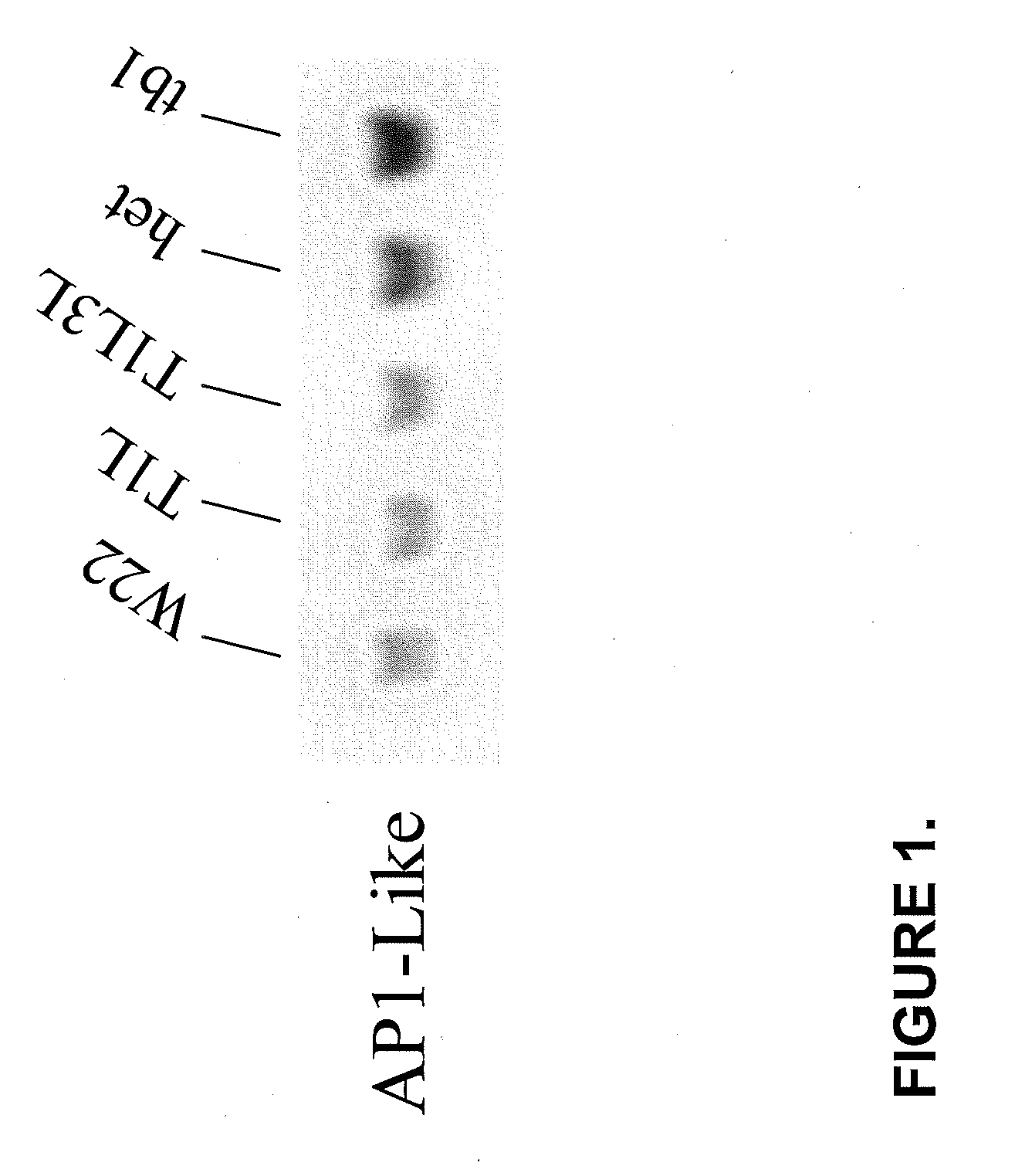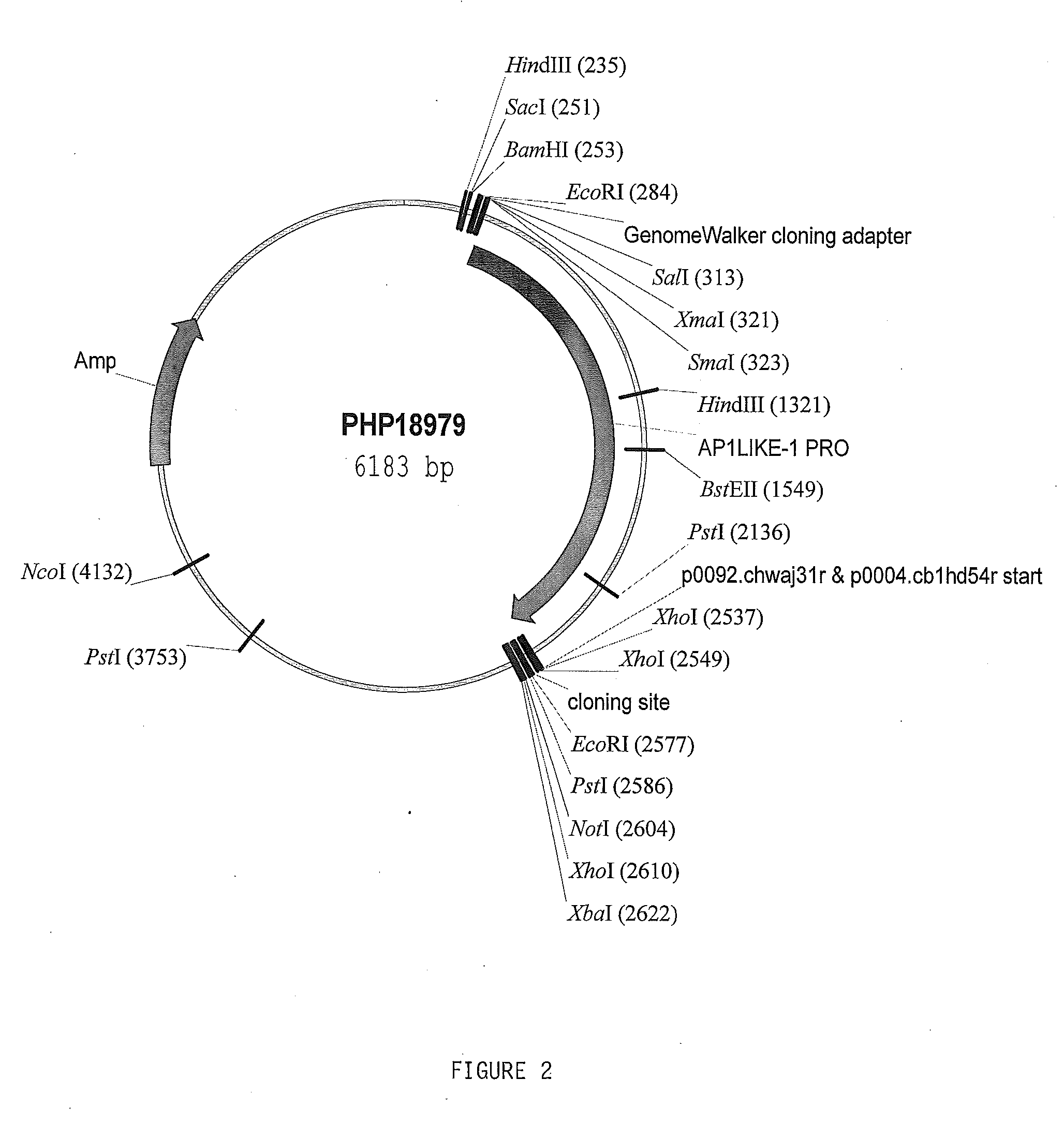Early-inflorescence-preferred regulatory elements and uses thereof
- Summary
- Abstract
- Description
- Claims
- Application Information
AI Technical Summary
Problems solved by technology
Method used
Image
Examples
example 1
Isolation of Promoter Sequences Using Genome Walker
[0074] The promoter of SEQ ID NO: 1 was isolated following identification of the maize AP1-like coding sequence via proprietary EST p 127.cntav71r. Genomic DNA upstream of the coding sequence for maize AP1-like gene was isolated from maize inbred B73 using the Universal GenomeWalker™ Kit sold by CLONTECH (Palo Alto, Calif.), following the manufacturer's protocol. Gene-specific primers used in the Universal GenomeWalker™ system were:
(SEQ ID NO: 6)PHN53490: CCCGCTCACTCTCGTCGCAGCAATGGTGAT
[0075] which was used with Clontech AP1 primer for the first round of PCR.
(SEQ ID NO: 7)PHN53489: GAAAGATCAGGTGCCTCTCGAGTCTCGACT,
which was used with Clontech AP2 primer for the second round of PCR.
example 2
Analysis of Expression of AP1-Like Gene
[0076] RNA was isolated from shoots of 4-week-old maize seedlings using the TriZol® method (Invitrogen, Carlsbad, Calif.). 15 μg total RNA was separated on 1% agarose MOPS-formaldehyde gels and blotted on Hybond™-N+ membrane (Amersham). The 1.2 kb full-length cDNA fragment from EST p0127.cntav71r was labeled using RediPrimell™ kit (Amersham) and hybridized to membrane in ExpressHyb™ (CLONTECH, Palo Alto, Calif.) at 65° C. overnight. The membranes were washed twice in 2×SSC, 0.1% SDS at room temperature and twice in 0.×SSC, 0.1% SDS at 50° C. The membranes were autographed to visualize hybridization signals.
[0077] AP1-like gene expression in the shoots of maize and Tb1 mutant maize plants is depicted in FIG. 1 for, left to right, wild-type plant (W22), W22 plant introgressed with the teosinte 1L chromosome (T1L), W22 plant introgressed with the teosinte 1L and 3L chromosomes (T1L3L), Tb1 / tb1-mum3 heterozygote (het) and tb1-mum3 homozygote (tb1...
example 3
Vector Construction
[0079] Using standard vector construction techniques known to those of skill in the art, a plasmid was prepared incorporating the AP1-like promoter of the invention (FIG. 2, FIG. 3, and SEQ ID NO: 2). Plasmid backbone was obtained from Japan Tobacco, Inc. (see, Komari, et al., (1996) Plant J. 10:165-174). Using similar means, other vectors were constructed comprising the expression cassettes described in Examples 4 through 6.
PUM
| Property | Measurement | Unit |
|---|---|---|
| Tm | aaaaa | aaaaa |
| temperature | aaaaa | aaaaa |
| temperature | aaaaa | aaaaa |
Abstract
Description
Claims
Application Information
 Login to View More
Login to View More - R&D
- Intellectual Property
- Life Sciences
- Materials
- Tech Scout
- Unparalleled Data Quality
- Higher Quality Content
- 60% Fewer Hallucinations
Browse by: Latest US Patents, China's latest patents, Technical Efficacy Thesaurus, Application Domain, Technology Topic, Popular Technical Reports.
© 2025 PatSnap. All rights reserved.Legal|Privacy policy|Modern Slavery Act Transparency Statement|Sitemap|About US| Contact US: help@patsnap.com



